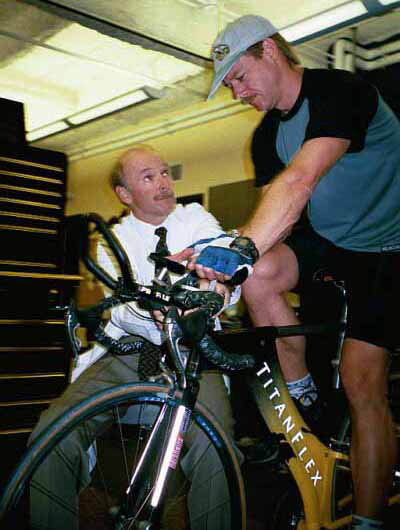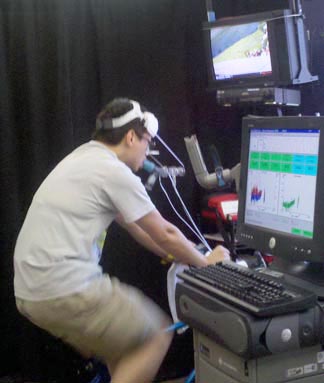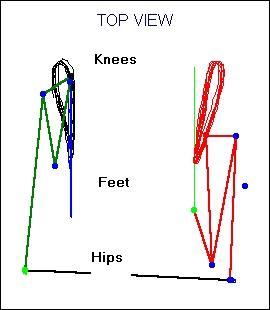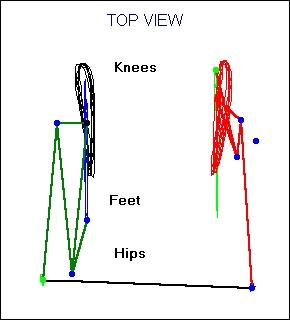Pruitt examines many professional and amateur cyclists. I have gone with dozens of different clients for bike fits with Pruitt at the Boulder Center for Sports Medicine.
Patient Exam
Pruitt begins each session by interviewing and examining the athlete:
- Why are you here? Are you having pain when you ride? Yes—what kind of pain?
- Do you suffer from knee pain? Do your knees ever click? Lock? Catch? Is it only a problem on the bike or during daily activities?
- What are your cycling goals?
- How much do you ride a year? Do you run? Hike?
- Do you lift weights? If so, do you lift year around or just in the winter? What exercises? Are your knees better or worse when you are lifting regularly?
- Have you had any traumatic injury to your knees?
- Do you have any reason to suspect your legs may not be the same length?

|
Andy Pruitt checking a
client’s bike fit.
|
Pruitt then does a physical exam, checking each knee joint for range of motion, testing flexibility, the integrity of the ligaments and listening for noise under the knee cap. He asks the rider to stand, looking for any hint that the legs are different lengths. He has the rider walk and examines how the feet land. If the feet roll in as the heel strikes, that will cause rider to walk and ride knock-kneed, stressing the knee joint.
Based on the rider’s history and the physical exam, he then orders one or several X-rays. For knee pain, a frontal picture of the knees is standard. Pruitt says this is like putting a car on an alignment machine. The knee cap should be perfectly aligned, equi-distant from each part of the joint. One rider had hyper-mobile knee caps. The patella is designed to move up and down; his also moved left and right causing pain. Pruitt also uses this view to check the alignment of the joint surfaces and the integrity of the cartilage that cushions the joint during motion. He can also examine the underside of the patella for roughness. This roughness or chondromalacia is common in all but the youngest cyclists.
If Pruitt suspects a leg length discrepancy, he also asks for an x-ray of the pelvis as the rider is standing. If one leg is shorter than the other, the pelvis will be tilted down on that side and, from the x-ray, Pruitt can measure the discrepancy. One rider, who’d suffered from serious back pain for years when cycling, had a 1-cm discrepancy. When Pruitt corrected for this, the pain disappeared.

|
Hughes’ client Jack Ruan
doing a lactate threshold and
VO2 max test at BCSM
|
Weight Lifting
Based on the interview, the exam, and the x-rays Pruitt will make some recommendations. For weight lifting, he recommends long lunges. This keeps the knee of the forward foot behind the toe and reduces strain on the knee. Squats (unless the rider has back problems) are also an excellent exercise for cyclists. Leg extensions are a no-no—the tremendous force that they put on the patella can exacerbate knee problems.
Knee Problems
For riders with knee problems, he suggests not running or hiking downhill, kneeling, or squatting for extended periods. Since the cartilage in my left knee is almost all gone, he said I shouldn’t even stand much.
For riders with chondromalacia, he recommends ramping up the training slowly and consistently. Chondromalacia doesn’t like sporadic training or big jumps in volume.
One rider was suffering from "spring knee", a common cycling problem. He’d been lifting a lot of weights and building up his mileage. Ramping up both the weightlifting and the cycling had caused an overload and strain of the extensor muscles.
Pruitt said that some aspiring ultra riders appear to have a glass ceiling, a training volume at which knee or other problems emerge and constrain the riding. The way to sneak through the glass ceiling is to build up very slowly and consistently.
3-D Bike Fit
The BCSM also offers dynamic 3-D bike fit. Reflective dots are positioned on the rider’s hips, knees, ankles and feet. Infrared cameras generate computer images of the cyclist in real time and adjustments can be tracked.
|
Before bike fit
Note side to side wobble of knees. Red lines below right knee are right thigh.
|

|
After bike fit
Knees track much better. Screen shot taken at a different moment in stroke so left quad is now illustrated..
|

|
Bike Fit
Dr. Pruitt mounts the bike on a trainer and has the rider spin against a light resistance. He begins by observing the rider from the rear and then from the side. One rider had only a 5-mm difference in leg length; yet, from the rear his left hip dropped noticeably as his shorter leg reached the bottom of the stroke.
Saddle Position
Pruitt starts by checking and adjusting the rider’s position over the cranks, working back and forth among different adjustments:
- with the foot at the bottom of the stroke, he uses a large protractor to measure the angle of the knee. In general, the lower the saddle height and the sharper the angle, the more power the rider has, but also the more stress at the back of the knee. A higher saddle height is better for endurance. For riders without knee pain, he adjusts the saddle height so that the angle is 30 to 35 degrees. For those of us with chondromalacia, he raises the saddle a little higher for a 25 degree angle.
- with the cranks at 3 and 9 o’clock, he drops a plumb bob to see if the patella is directly over the end of the crank. In my case, he moved the saddle forward 1-cm, which should increase my power into the cranks.
- if the legs are not the same length, he’ll move the cleat back on the shoe of the longer leg, effectively shortening it, and then shim the cleat on the shorter leg.
- he asks the rider to pedal and observes from the rear. Has he moved the saddle too high so that the hips are rocking? Are the knees going straight up and down over the toes? My legs are the same length, but my right knee goes inward at the top of the stroke and almost brushes the top tube, instead of tracking up and down over my second toe. If the rider is knock kneed (like me), Pruitt will put a small wedge under the cleats on the inside of each shoe, so that the foot tilts slightly outward and the knee action is straight up and down. If the rider’s knees go outward at the top of the stroke, Pruitt will move the feet outward. He’ll slide the cleats to the inside of the shoes and, if that isn’t enough, suggest putting a washer spacer between the pedal axles and the crank to move the pedals outward slightly.
After each of these adjustments, Pruitt then re-checks the other aspects. Did he adjust the cleats so much because of knee pain that the change might lead to back pain? If he slid the seat forward or back, then he’ll readjust the saddle height for the desired knee angle. For distance riders, he also suggests that after setting the saddle in a neutral road position, we may want to slide it forward just a little so that we sit on the wider part.
Stem and Handlebars
Now we’re dialed in over the power train and can ride pain-free for days, right? No—often upper body pain is the real problem, and Pruitt is equally meticulous in checking the position of the torso, shoulders and arms. He starts with a question: when standing, can you easily bend over and touch your toes? If not, you have a stiff lower back and/or tight hamstrings and he’ll compensate as he sets your upper body position.
- he has the rider sit with the hands on the brake hoods and the arms flexed ever so slightly, the classic relaxed road position. In this position, the torso should form about a 45 degree angle with the top tube. When the rider looks down, the handlebars should obscure the front hub. But, if the rider can’t touch his toes, then this position is too stretched out for the rider and Pruitt will suggest a shorter stem.
- how far below the seat is the top of the stem? Two to four inches is a normal range; more of a drop is aggressive and may lead to back pain on a long ride.
- with the rider’s hands in the drops, he then looks to see if the torso and top tube angle is 30 degrees or more.
- if the rider is using aero bars, he checks the torso angle with the rider on the aero bars. The angle should be at least 30 degrees. Less may be more aerodynamic and great for a 40K time trial, but won’t be comfortable for a long ride.
- On the aero bars, what is the angle between the shoulders and the upper arms? Ideally, it’s 90 degrees so that the elbows are under the shoulders. My aero bar pads are forward. With my elbows out there, the angle is closer to 120 degrees—no wonder I have tight, sore shoulders by the end of the day.
Because we spend so much time on our bikes, proper bike fit is very important for ultra riders. In every tour a few riders sag and in every race a few riders drop because of injuries due to an improper marriage between rider and bike.
University of Colorado Sports Medicine and Performance Center (formerly the Boulder Center for Sports Medicine.)
Retul was founded by bike fit specialists trained at the Boulder Center for Sports Medicine (BCSM). Bike shops around the world has bike fit technicians trained by Retul
More Information
- Butt, Hands, Feet: Preventing and treating pain in cycling's pressure points — my 12-page eArticle for $4.99 from RoadBikeRider.com.
- Preventing Cycling's Ailments bundle: my four articles on points of contact, nutrition, cramps and using sports psychology — 56 pages for $15.96 from RoadBikeRider.com.
- Stop Cycling’s Showstoppers: How to prepare for and finish rides no matter what comes up—my 65-page eBook for $14.95 from RoadBikeRider.com.
- Other articles by Coach Hughes from RoadBikeRider.com
Originally printed in UltraCycling













